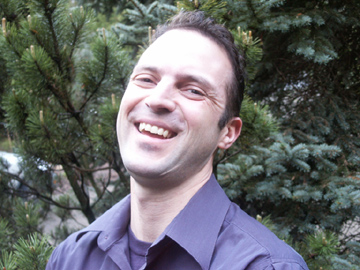
| Shaffer Fine Art Gallery | 1111 SW Alder St, Portland, OR 97205 | 503-295-4979 | info@shafferfineart.com |
Back to The Art of Tim Chilina
Biography of Tim Chilina

|
Artist I grew up in a sleepy suburb of Tacoma, Washington. After obtaining a B.S. in Chemistry from Oregon State University in 1991, I moved to Portland, Oregon, where I currently live and work as an artist. I love the Pacific Northwest, and though I have traveled to many places I will always call it my home. My experiences, peers, and my own aesthetic are the guides for my creative process. With relatively little formal education in the arts, I have relied on observation, experimentation, and persistence to acquire new skills and to facilitate the evolution of my work. A background in chemistry has proven invaluable in understanding and influencing the physical nature and behavior of glass. Over the next several years, I plan to continue exploring attributes of glass and encaustic as aesthetic tools of sculptural composition. By focusing on innovative materials and techniques, I hope to expand the set of creative tools that are available to artists who work in these unique and fabulous media
Glass I love working with glass: its heat, fluidity, and its physical demands. Each piece is a new adventure and presents its own unique challenges. Blown glass is a process, and each finished piece documents its evolution. The nature of the medium invites interrelation between color and shape. Color and pattern are a primary focus of my work. Traditional and abstract components of form translate to specific elements of dimensional energy that combine with color and pattern to create dynamic presence. Some of the more sculptural works have assimilated figurative characteristics. Others have captured elements of transmitted light and shadow via suspension. The interactive participation of the audience and the surrounding environment is also key factor in the complete aesthetic. The blowing process begins with concentrated colored glass on the end of a blowing pipe. Colored glasses are layered and manipulated according to the final color, shape, and size of the piece. The patterns in each piece arise from several fine layers of solid and crushed colors (know as frit). Molten, colorless glass is gathered from a furnace around a core of concentrated color, completely encasing it. The clear glass provides structural integrity to the finished piece. As a piece is shaped and blown, the bubble expands through color layer, which subsequently expands outward through the clear glass. A finished piece has a very thin layer of the concentrated colored glass on its inside surface, with a more substantial layer of clear glass on the outside. Gravity, centrifugal force, water, fire, and wooden and metal tools are used to shape each piece, which is reheated numerous times throughout the process. Once its approximate size and shape has been determined, a piece is transferred from the blowing pipe to a steel rod (punty). A hole remains where the piece was previously attached to the pipe. The piece is further manipulated and shaped, which results in the expansion of this hole. A final shape is attained after several iterations of re-heating and manipulation. The piece is then placed in an electric kiln (950 F) to slowly cool under controlled conditions, which reduces the internal stress in the glass on the molecular level. Many of the pieces have a metallic finish or luster on their inside surfaces. This arises from the particular metals (primarily silver) that are used to color the glass. The metals are chemically reduced from their salts back to the metallic state with the reductive flame of a propane torch. These metals may also react with one another to produce striking effects. For instance, the gold of transparent pinkish-red glass reacts with the silver in transparent blue glass to make opaque teal, green, and yellow shades, often with subtle patterns and textures. The landscape qualities of individual pieces utilize the chemical reactions of the colored glasses to attain their interesting characteristics, and subtleties of such reactions distinguish the uniqueness of each piece.
Encaustic I also love encaustic: the embodiment of light, luster, color, and texture. These characteristics are dramatically amplified through its union with glass. Abstract composition evokes the Intrascape, an internal landscape that arises from a unique dialog between audience and aesthetic. Angular and geometrical components echo contemporary minimalism, providing a quiet focus, while color and texture capture undertones and sensibilities of the contemporary age. Suspension provides a dimensional boundary and facilitates an uncommon integration with the external world. The medium of encaustic essentially consists of pigmented wax. Ultimately, the characteristics of the wax give rise to the unique luster, translucency, and texture of the medium. Beeswax, normally yellow to brown in color, is mixed in a molten state with talc and charcoal. Pollen and other contaminants may then be removed by filtration. Wax and Damar resin are subsequently combined in an 8:1 ratio; this tempering of the vehicle results in a wax with improved hardness and other properties. Traditional pigments are subsequently added to color the encaustic medium. A piece of tempered glass provides a firm, forgiving, and transparent substrate for the composition. Layers of pigmented wax are brushed, dripped, splattered, and poured with such implements as brushes, a stainless-steel turkey baster, and measuring cups. The natural surface tension of molten encaustic plays a significant role throughout the process. Layers are fused together with additional heat from an electric heat gun. Textures may be imparted by scratching, scraping, and carving the wax surface, or with crumpled sheets of foil or similar materials. The wax also acts as a viable adhesive for other materials in the pieces, which may include sheet glass, tumbled glass, cane, dichroic glass, copper foil and tube, and metallic leaf.
Tim Chilina Portland, Oregon November 2008
|

![]()